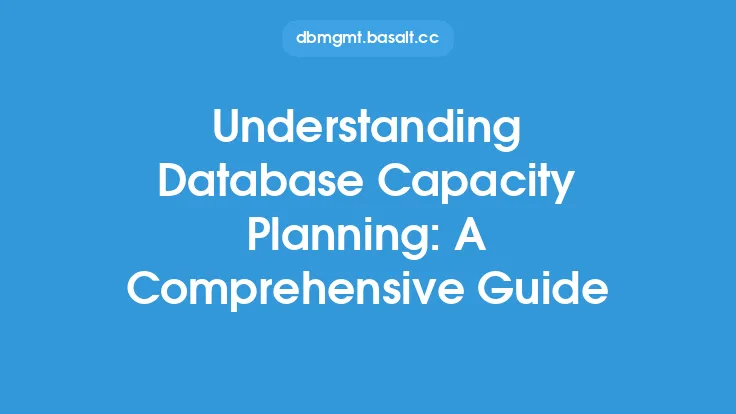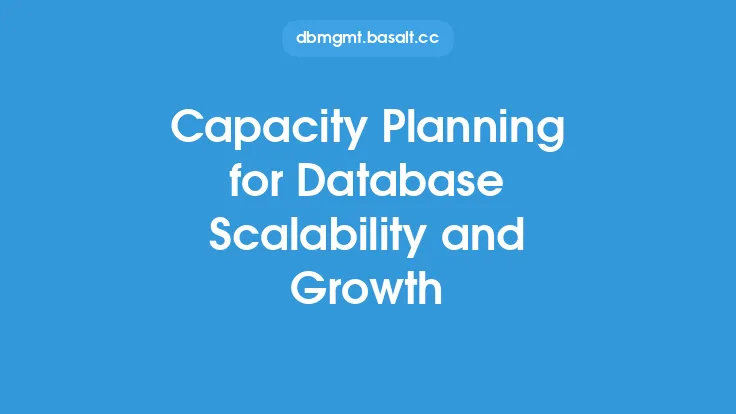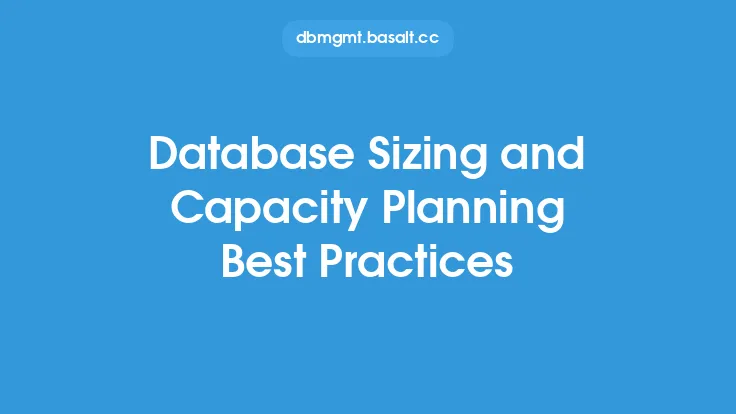Database capacity planning is a critical aspect of database design, as it ensures that the database can handle the expected workload and data volume. To achieve this, database administrators (DBAs) and developers rely on various tools and techniques to plan and manage database capacity. In this article, we will delve into the different database capacity planning tools and techniques, exploring their features, benefits, and applications.
Introduction to Database Capacity Planning Tools
Database capacity planning tools are software applications designed to help DBAs and developers assess, plan, and manage database capacity. These tools provide a range of features, including performance monitoring, capacity analysis, and forecasting. Some popular database capacity planning tools include Oracle Enterprise Manager, Microsoft SQL Server Management Studio, and IBM DB2 Performance Management. These tools offer a centralized platform for monitoring and managing database performance, allowing DBAs to identify potential capacity issues and take proactive measures to address them.
Techniques for Database Capacity Planning
Several techniques are used in database capacity planning, including:
- Baseline analysis: This involves collecting and analyzing data on current database performance and capacity. Baseline analysis helps DBAs understand the database's current state and identify areas for improvement.
- Trend analysis: This technique involves analyzing historical data to identify trends and patterns in database usage and growth. Trend analysis helps DBAs forecast future capacity requirements and plan accordingly.
- What-if analysis: This technique involves simulating different scenarios to predict the impact of changes on database capacity. What-if analysis helps DBAs evaluate the potential effects of changes, such as adding new users or applications, on database performance and capacity.
- Capacity modeling: This involves creating a mathematical model of the database to simulate its behavior under different workload and capacity scenarios. Capacity modeling helps DBAs predict the database's performance and capacity requirements under various conditions.
Database Performance Monitoring Tools
Database performance monitoring tools are essential for database capacity planning. These tools provide real-time monitoring and analysis of database performance, helping DBAs identify potential issues and optimize database configuration. Some popular database performance monitoring tools include:
- Oracle Enterprise Manager: This tool provides comprehensive monitoring and management capabilities for Oracle databases.
- Microsoft SQL Server Management Studio: This tool offers a range of monitoring and management features for Microsoft SQL Server databases.
- Nagios: This tool provides monitoring and alerting capabilities for various database platforms, including Oracle, Microsoft SQL Server, and MySQL.
- Prometheus: This tool offers monitoring and alerting capabilities for cloud-native databases and applications.
Capacity Planning for Virtualized and Cloud-Based Databases
Virtualized and cloud-based databases introduce new challenges for database capacity planning. In these environments, DBAs must consider the impact of virtualization and cloud computing on database performance and capacity. Some techniques for capacity planning in virtualized and cloud-based databases include:
- Resource pooling: This involves allocating resources, such as CPU and memory, to virtualized databases based on their workload and capacity requirements.
- Dynamic resource allocation: This involves dynamically allocating resources to virtualized databases in response to changes in workload and capacity requirements.
- Cloud-based monitoring and analytics: This involves using cloud-based monitoring and analytics tools to track database performance and capacity in cloud-based environments.
Best Practices for Database Capacity Planning
To ensure effective database capacity planning, DBAs and developers should follow best practices, including:
- Regular monitoring and analysis: Regularly monitor and analyze database performance and capacity to identify potential issues and optimize database configuration.
- Capacity forecasting: Forecast future capacity requirements based on historical trends and growth patterns.
- What-if analysis: Perform what-if analysis to evaluate the potential impact of changes on database capacity and performance.
- Collaboration: Collaborate with stakeholders, including developers, users, and management, to ensure that database capacity planning aligns with business requirements and goals.
Conclusion
Database capacity planning is a critical aspect of database design, and DBAs and developers rely on various tools and techniques to plan and manage database capacity. By understanding the different database capacity planning tools and techniques, including performance monitoring, capacity analysis, and forecasting, DBAs can ensure that their databases are optimized for performance and capacity. Additionally, by following best practices, such as regular monitoring and analysis, capacity forecasting, and collaboration, DBAs can ensure that their databases are aligned with business requirements and goals.





